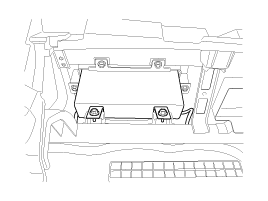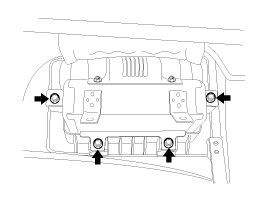Hyundai Tucson: Airbag Module / Passenger Airbag (PAB) Module Repair procedures
Hyundai Tucson (LM) 2010-2015 Service Manual / Restraint / Airbag Module / Passenger Airbag (PAB) Module Repair procedures
| Removal |
| 1. |
Disconnect the battery negative cable and wait for at least three minutes before beginning work. |
| 2. |
Remove the glove box housing. (Refer to the Body group- crash pad). |
| 3. |
Disconnect the passenger airbag connector and remove the PAB mounting bolt.
|
| 4. |
Remove the crash pad. (Refer to the Body group- crash pad).
|
| 5. |
Remove the heater duct from the crash pad. |
| 6. |
Remove the mounting nuts (4EA) from the crash pad. Then remove the passenger airbag.
|
| Installation |
| 1. |
Remove the ignition key from the vehicle. |
| 2. |
Disconnect the battery negative cable from battery and wait for at least three minutes before beginning work. |
| 3. |
Place a passenger airbag on the crash pad and tighten the passenger airbag mounting bolts.
|
| 4. |
Install the heater duct to the crash pad. |
| 5. |
Install the crash pad. (Refer to the Body group- crash pad) |
| 6. |
Tighten the passenger airbag mounting bolt.
|
| 7. |
Connect the passenger airbag harness connector to the SRS main harness connector. |
| 8. |
Reinstall the glove box. (Refer to the Body group- crash pad) |
| 9. |
Reconnect the battery negative cable. |
| 10. |
After installing the passenger airbag (PAB), confirm proper system operation:
|
 Side Airbag (SAB) Module Description and Operation
Side Airbag (SAB) Module Description and Operation
Description
The Side Airbags (SAB) are installed inside the front seat
and protects the driver and passenger from danger when side crash
occurs. The SRSCM determines deployment of side airbag b ...
Other information:
Hyundai Tucson (LM) 2010-2015 Owners Manual: Electronic Stability Control (ESC)
The Electronic Stability Control (ESC) system helps to stabilize the vehicle
during cornering maneuvers.
ESC checks where you are steering and where the vehicle is actually going. ESC
applies braking pressure to any one of the vehicle’s brakes and intervenes in the
engine management sys ...
Hyundai Tucson (LM) 2010-2015 Service Manual: Fuel Tank Pressure Sensor (FTPS) Specifications
Specification
Pressure [kPa (kgf/cmx, in H2O)Output Voltage (V)-6.67 (-0.068, -26.8)0.502.5+6.67 (0.068, 26.8)4.5
...
© 2010-2025 www.htmanual.net





